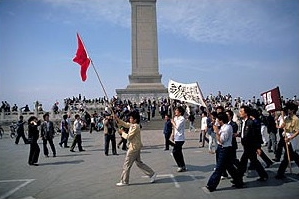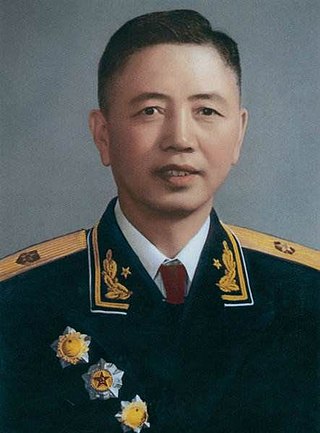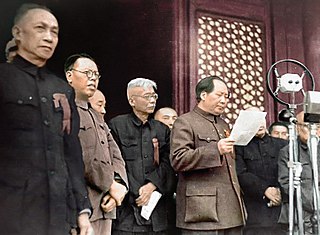
The Tiananmen Square protests, known in China as the June Fourth Incident were student-led demonstrations held in Tiananmen Square, Beijing, China, lasting from 15 April to 4 June 1989. After weeks of unsuccessful attempts between the demonstrators and the Chinese government to find a peaceful resolution, the Chinese government declared martial law on the night of 3 June and deployed troops to occupy the square in what is referred to as the Tiananmen Square massacre. The events are sometimes called the '89 Democracy Movement, the Tiananmen Square Incident, or the Tiananmen uprising.

Liu Huaqing was Chinese revolutionary and an admiral of the People's Liberation Army Navy, who served as the third Commander-in-Chief of the Navy from 1982 through 1988. He is considered to have greatly contributed to the modernization of the Chinese Navy, and is hailed as the "father of the modern Chinese Navy" and "father of Chinese aircraft carriers".
Chen Xitong was a member of the Politburo of the Chinese Communist Party and the Mayor of Beijing until he was removed from office on charges of corruption in 1995.

The 27th Group Army was a military formation of the People's Republic of China's People's Liberation Army and one of three active group armies belonging to the Beijing Military Region between 1949 and 2017. It was based in Shijiazhuang, Hebei. By 2013, the army included the 80th, 82nd, 188th, and 235th Mechanized Infantry Brigades, and the 7th Armored Brigade, plus the 12th Artillery and an AAA brigade.

Qin Jiwei was a general of the People's Republic of China, Minister of National Defense and a member of the Chinese Communist Party Politburo.

Chen Xilian was a Chinese military officer and politician, general of the People's Liberation Army. A prominent Maoist, he held very important positions in both military and political spheres.

During the 1989 Tiananmen Square protests and massacre in Beijing, the Chinese People's Liberation Army (PLA) played a decisive role in enforcing martial law, using force to suppress the demonstrations in the city. The killings in Beijing continue to taint the legacies of the party elders, led by Chinese leader Deng Xiaoping, and weigh on the generation of leaders whose careers advanced as their more moderate colleagues were purged or sidelined at the time. Within China, the role of the military in 1989 remains a subject of private discussion within the ranks of the party leadership and PLA.
The 1989 Tiananmen Square protests and massacre were the first of their type shown in detail on Western television. The Chinese government's response was denounced across the world; a report by the U.S. State Department said: "Foreign governments have expressed near universal revulsion over the crackdown although a few exceptions have supported China's approaches. Negative reactions range from punitive measures by Western countries to private criticisms in the East." Specifically, it said: "China's credentials as a socialist reformer were being called into question not only by Western European communists but also by progressives in Eastern Europe and, to a lesser extent, the Soviet Union." Notably however, many Asian countries remained silent throughout the protests; the government of India responded to the massacre by ordering the state television to pare down the coverage to the barest minimum, so as not to jeopardize a thawing in relations with China, and to offer political empathy for the events. Criticism came from both Western and Eastern Europe, North America, Australia and some east Asian and Latin American countries. North Korea, Cuba, Czechoslovakia, and East Germany, among others, supported the Chinese government and denounced the protests. Overseas Chinese students demonstrated in many cities in Europe, America, the Middle East, and Asia against the Chinese government.

Xu Qinxian was a Chinese major general of the People's Liberation Army. As commander of the 38th Group Army, he refused the order to use force against demonstrators in Beijing during the 1989 Tiananmen Square protests and massacre. As a result, Xu was court-martialed, jailed for five years and expelled from the Chinese Communist Party. After serving his sentence, he was exiled to Shijiazhuang, Hebei, where he spent the remainder of his life.
The 28th Group Army was an army corps of the Chinese People's Liberation Army that existed from 1949 to 1998. From 1952 to 1971, the 28th Army was based in Putian, Fujian and belonged to the Fujian Military Region. From 1971 to 1998, this army corps belonged to the Beijing Military Region and was based in Shanxi Province, initially in Houma and then in Datong. At the time of its dissolution in 1998, the 28th Army was composed of the 82nd, 83rd and 205th Infantry Divisions, the 7th Armored Division, an artillery brigade, an anti-aircraft brigade, an engineer regiment, a communication regiment and a reconnaissance battalion. The army corps’ unit ID number was 51366.
The April 27 demonstrations were massive student protest marches throughout major cities in China during the 1989 Tiananmen Square protests. The students were protesting in response to the April 26 Editorial published by the People's Daily the previous day. The editorial asserted that the student movement was anti-party and contributed to a sense of chaos and destabilization. The content of the editorial incited the largest student protest of the movement thus far in Beijing: 50,000–200,000 students marched through the streets of Beijing before finally breaking through police lines into Tiananmen Square.

Jiang Jielian was a second-year student at the High School Affiliated to Renmin University of China. He was killed by People’s Liberation Army (PLA) behind a flower bed in front of Building 29, on the north side of Fuwai Street, Muxidi, Beijing, at the age of 17 when PLA units advanced on Tiananmen Square to crack down on the student-led demonstrations. After the June 4 massacre, Jiang was the first casualty of high school age whose death was acknowledged in internal bulletins by the Chinese Communist Party (CCP) authorities. According to the authorities, Jiang was one of "more than two hundreds" of Beijing citizens who got shot or killed while trying to stop the PLA units from entering Beijing on the night of June 3, 1989. The real figure remained unknown but predicted as at least seven times higher. Jiang's death also triggered the Tiananmen Mothers movement, which was initiated and organized by Jiang's parents, Jiang Peikun and Ding Zilin, both of whom were professors at Renmin University of China. During an interview with a Canadian journalist on June 4, 1993, Ding said, "My government called him a rioter but he was not. He was a student who only had the idea of democracy".
The first of two student hunger strikes during the 1989 Tiananmen Square protests and massacre began on May 13, 1989, in Beijing. The students said that they were willing to risk their lives to gain the government's attention. They believed that because plans were in place for the grand welcoming of Mikhail Gorbachev, the General Secretary of the Communist Party of the Soviet Union, on May 15, at Tiananmen Square, the government would respond. Although the students gained a dialogue session with the government on May 14, no rewards materialized. The Chinese Communist Party (CCP) did not heed the students' demands and moved the welcome ceremony to the airport.

The People's Republic of Amnesia: Tiananmen Revisited is a nonfiction book by journalist Louisa Lim and published by Oxford University Press in 2014. It explores the lives of people who were affected by the Tiananmen Square protests of 1989 and the June 4 Tiananmen Square massacre in China. Lim uses personal accounts to tell the story of the 1989 student protests and their aftermath.
The 1989 Tiananmen Square protests and massacre were a turning point for many Chinese Communist Party (CCP) officials, who were subjected to a purge that started after June 4, 1989. The purge covered top-level government figures down to local officials, and included CCP General Secretary Zhao Ziyang and his associates. The purge took the form of a massive ideological campaign that lasted 18 months. At least 4 million Communist Party members were under some sort of investigation. The government stated that the purge was undertaken for the purpose of “resolutely getting rid of hostile elements, antiparty elements, and corrupt elements" as well as "dealing strictly with those inside the party serious tendencies toward bourgeois liberalization” and purify the party.
The Chengdu Protests started out as a memorial gathering to mourn Hu Yaobang's death in Tianfu Square and it took around five days before larger-scale protests broke out. While the Chengdu students were protesting in support of the students in Beijing, they were demanding different things than the Beijing students.
The 1989 Tiananmen Square protests and massacre, commonly known in mainland China as the June Fourth Incident, were student-led demonstrations in Beijing in 1989. More broadly, it refers to the popular national movement inspired by the Beijing protests during that period, sometimes called the '89 Democracy Movement. The protests were forcibly suppressed after Chinese Premier Li Peng declared martial law. In what became known in the West as the Tiananmen Square Massacre, troops with assault rifles and tanks fired at the demonstrators trying to block the military's advance towards Tiananmen Square. The number of civilian deaths was internally estimated by the Chinese government to be near or above 10,000.
The 35th anniversary of the founding of the People's Republic of China took place on 1 October 1984. A military parade was held in Tiananmen Square in Beijing and various celebrations were conducted all over the country. China's paramount leader Deng Xiaoping inspected the troops along Chang'an Avenue in Beijing. This parade was immediately followed by a civilian parade.

The founding of the People's Republic of China was formally proclaimed by Mao Zedong, the Chairman of the Chinese Communist Party (CCP), on October 1, 1949, in Tiananmen Square in Beijing. The government of a new state under the CCP, formally called the Central People's Government, was proclaimed by Mao at the founding ceremony.
Zhang Meiyuan was a major general in the People's Liberation Army of China who served as commander of the 38th Group Army from 1989 to 1994 and commander of the Qinghai Military District from 1993 to 1996.









